|
Toa Payoh
Vets Clinical Research
Making veterinary surgery alive
to a veterinary student studying in Australia
using real case studies and pictures |
Buying Time
For An Old Companion - Circum-anal tumours -
Part 2
Dr
Sing Kong Yuen, BVMS (Glasgow), MRCVS
First written: 09 June, 2009
Date:
21 September, 2011 |
 toapayohvets.com toapayohvets.com
Be Kind To Pets
Veterinary Education
Project 2010-0129 |
|
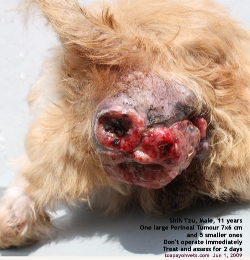 First Consultation in June 2009 First Consultation in June 2009
Circum-anal tumours - Jun 2009. Two vets had not wanted to perform the
surgery, probably forecasting that the dog would die of old age anyway.
However, the old dog outlived the growing tumours and caused lots of
maintenance in the house as blood splattered all over the floor every day. |
|
Update in February 2010 |
I did not phone the
owner to get the dog neutered as this would seem like
being a desperado trying to tout for business. In
the interest of the old dog, I should do it but I did
not. He barely survived the anaesthesia in June
2009 and I don't want to risk my reputation operating on
a very high-risk case. The chances of survival were so
overwhelming low that it would be best for me not to
seek such cases as human emotions on a dead dog after
surgery are very high.
The owner consulted me 8 months later. The tumours
recurred and grew with a vengeance. With a heavy heart,
I did the surgery. This time the owner did come back for
neutering. An anti-androgenic injection was given. The
owner did not return for the second injection. The
surgery is presented below:
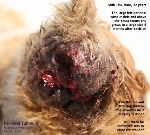 |
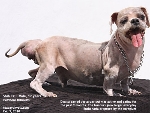 |
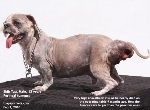 |
|
As the dog was about to die during
the first anaesthesia, not all
circum-anal tumours were excised.
Circum-anal tumours - Jun 2009 |
If I had persisted in continuing
the surgery when the dog's
anaesthetic signs indicated
imminent cardiac failure, the dog
would have died. A second surgery
should be done one month later
when the dog has better health.
However, the owner did not return.
|
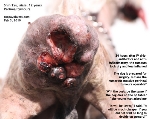 |
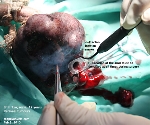 |
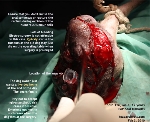 |
|
The other circum-anal tumours had
explosive growths 8 months after
the first surgery. |
Electro-incision was initiated.
Electro-surgery was used for skin
incision and is of no further use
in this case as the tumours were
wide-spread and not in discrete
lumps. Surgery in aged dogs must
be completed fast in order to
reduce risk of anaesthetic deaths.
|
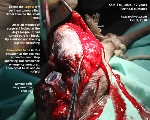 |
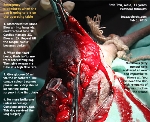 |
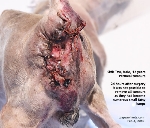 |
|
A bloody operation. Almost all the
subcutaneous tumour and cells were
excised.
|
No histopathology was done to save
the owner money. Neutering would
be done 2 weeks later.
|
Stitch breakdown is common in this
case. The wounds were cleaned
daily by the owner at home. |
|
|
Update in June 2010 |
I did not follow up
on this case as I expected a very poor prognosis. I
expected that the dog would have recurrence again. The
owner did not come for a second anti-androgen injection
which is highly recommended to reduce any growth of
circum-anal tumours.
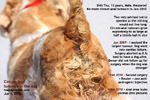 Again I should have phoned him to come for the
injection. I did not want to tout for business and I did
not phone him. Recession had set in and I could
understand that the two surgeries had cost the owner
over $1,000. Again I should have phoned him to come for the
injection. I did not want to tout for business and I did
not phone him. Recession had set in and I could
understand that the two surgeries had cost the owner
over $1,000.
On a fine sunny afternoon of June 4, 2010, the
son-in-law phoned me as the dog had facial itchiness and
infections. "How's his backside?" I asked the son-in-law
who had phoned me for an appointment. "Very good. No
tumours have grown." This was excellent news. I just
would not believe him.
As he was busy, I offered to drive to his apartment to
get the dog. His
mother would bring the dog in a crate down to the void deck. My
assistant Mr Saw would pick him up, put him in a crate
and return to my car while I was waiting at the
road-side. "Has he got perianal tumours?" I
asked Mr Saw as he approached me. "No, Doctor"
he said. I could not believe him. The tumour had
recurred since the first operation in Jun 2009 and now
he told me that there was no recurrence. How could that
be? It was not logical.
Indeed, his backside
looked normal. He bites people and so Mr Saw and I had
to be very careful when we handle him.
Advices:
It was only 4 months after the second surgery. The
logical scientific explanation is that the dog had been
neutered. This deprived the circum-anal tumours of
testosterone which fueled its growth. It is a known fact
that neutered dogs rarely suffer from circum-anal
tumours and therefore this dog had no further
recurrence. Cause and effect. Neuter and no circum-anal
tumours recurring as compared to the first June 2009
surgery. The owner had complied with veterinary
instructions to get the dog neutered after the 2nd
surgery in Feb 2010. Therefore, the dog benefited in
having a high quality of life by having a pain-free
normal backside. However 4 months is too early to come
to a conclusion as it takes 5 years to know whether the
tumour (most likely malignant) will recur. It would
likely recur if it was malignant.
The anal
area should be examined weekly and the anti-androgen
injections given when the tumours recur. Compliance may
be difficult as almost all owners leave the backside
alone unless the dog is licking it or blood drips onto
the floor.
 Never
harbour negative mental thoughts when you encounter
challenges in life. They suppresses your own immune
system and cause you to fail in life.
Adopt a positive mental attitude when you operate on
circum-anal tumours in the old dog. Never
harbour negative mental thoughts when you encounter
challenges in life. They suppresses your own immune
system and cause you to fail in life.
Adopt a positive mental attitude when you operate on
circum-anal tumours in the old dog. |
COPY OF A REPORT IN
MY BLOG.
http://2010vets.blogspot.com/2010/06/95-perianal-tumours-in-dog.html |
In the afternoon of
June 3, 2010, I had taken out the files of the old Shih
Tzu with gigantic perianal tumours and gave a review of
this case to a new intern who was a Junior College Year
2 student from Raffles Institution.
I had driven back to the surgery with an old Shih Tzu
that had large perianal tumours excised by me four
months ago. However his tumours had not recurred, so the
old illustrations in my case sheets would be the only
way to educate her. I do illustrate my surgical cases
for review and to give to my clientele to educate them
and their families.

For the benefit of readers, the tumour case is described
at:
Buying Time For An Old Companion - Cicum-anal (perianal)
tumours in a male Shih Tzu
http://www.sinpets.com/dogs/20100533perianal_circum_anal_tumours_dogs_ToaPayohVets.htm
Jun 2009. Surgery aborted as the dog went into cardiac
failure. Only the largest tumour was excised.
To continue surgery would be very foolish as no owner
wants a dead dog with a completed surgery
Feb 2010. Dog came with larger tumours
Jun 2010. No recurrence of circum-anal tumours for the
past 4 months after excision, neutering and an
anti-androgenic injection. So is he fully cured?
Weekly monitoring of the anal area during bath-time will
be ideal and any small tumours be resected or reduced by
an anti-androgenic injection. But which owner would
remember to do the weekly checking for perianal tumours?
"I have not seen many cases of perianal tumours as they
predominantly occur in male un-neutered dogs," I said to
the intern. The old Shih Tzu I drove back in my car now
had a normal backside and so I could not show her the
real thing. "Perianal tumours, also know as circum-anal
tumours seldom present themselves in neutered male dogs
or female dogs. Many Singapore dogs are sterilised as
dog licence fees are much lower. This is why there are
so few cases."
In the evening, I visited a veterinary surgery whose
founder is an old colleague of mine during our
employment by the Primary Production Department (PPD),
Singapore. The PPD is now called the AVA (Agri-Food and
Veterinary Authority.
"How many cases of perianal tumours have you seen?" I
asked the founder's son who was on duty. His mum had not
been in good health and was not in the practice.
The son would be at least 30 years old. I could remember
him as a 10-year-old running around in his mum's surgery
when I was doing locum some two decades ago. Now he is a
young father and have to bear the responsibilities of
taking over the practice.
On this fine evening, I was shocked to see that he had
both sides of his head shaved bald, leaving a central
high turf of hair bleached brown. I could never imagine
he would be this fashionable when he was half my height
during his childhood days.
The son said: "I don't see many cases. There is one
10-year-old Alsatian in the Army having this anal
problem. The Army would not send it for treatment and I
donated some of my cream for the dog."
"Is the dog suffering from anal fistulas? Or circum-anal
tumours? Why don't you get him treated?" I asked.
"The Army takes a long time to decide on treatment," the
son said. "There are many considerations before a sick
dog can be sent to the vet for treatment. The Army sends
their dogs to two veterinary practices if necessary."
"Why don't you ask the Army to send the old dog to me
for surgery?" I asked him. "I will charge $100 for
everything to be done." The son who was doing reservist
duties in the Singapore Armed Forces Provost Unit's Dog
Company. I was a veterinarian in charge of the health of
guard dogs and tracker dogs in this Dog Company when I
was doing my National Service in the early 1970s and am
concerned about the health of this old guard dog.
"It is not so easy to send a sick dog to the vet for
treatment," the son said. "The Army has to be careful of
expenditure and has to justify."
This is a sad state of affairs as Singapore is a
developed country and a retired guard dog's painful
backside does not get treatment.
One can be idealistic but in reality, any complaint from
me to the Commanding Officer would likely lead to
euthanasia of the old dog. For $100, a retired dog's
life is terminated by the bureaucracy. But which is
worse? Suffering from a painful backside daily but being
alive or death by lethal injection? Has the dog any
choices? Is there public funding for such cases for
retired army dogs? There must be a fund to treat
retired military dogs. In the meantime, I have to store
away my idealism by keeping quiet. Rocking the boat will
mean death of this dog as I doubt that the Army would
even organise transport to get the dog treated for free.
At the surgery, I borrowed the son's new thick cat
medicine book "Problem-based Feline Medicine" by Jacquie
Rand, Edition 2007. I wanted to read more about a
condition in cat where the mucous membranes of the cat's
fauces are swollen and edematous. This surgery had many
stray cat cases and this was why I came to ask the
founder and her son about one case I encountered
recently. It was an immune disease as prednisolone
reduced the swelling by 50% the next day.
The name of the condition is plasmacytic-lymphocytic
stomatitis/faucitis. My case was severe faucitis as the
cat did not have inflammation of the tongue or gums.
What a name for vet students or even vets to remember.
"Where's Dr Sing?" the receptionist said in a loud
voice. I was sitting on the sole chair at the waiting
area to her left but she could not see me. She had
phoned a young couple to come to the surgery me after
asking me how much I charged for surgery to excise the
circum-anal tumours.
The couple had been to another vet since this surgery
did not provide this service. The fees quoted was over a
$1,000 and the couple must have sought the advice of the
receptionist who asked me about my fees since I was
present.
"Didn't you talk to the vet about the cost of over
$1,000 perianal surgery?" I asked the couple.
"No," the young-looking wife whom I estimated to be in
her 30s said. "A driver sent our dog to the vet." She
looked young as contrasted to her husband who has many
silvery grey hairs.
"Veterinary costs are now higher as many younger vets
are more careful about litigation and demand blood
testing prior to surgery." I said. "My generation
appears backwards as we would have simply operated.
However, nowadays, in a litigious society, there is no
strong defence against professional negligence if the
dog dies under anaesthesia if blood tests have not been
done."
I asked the wife about the size of the tumour and to
illustrate on a piece of paper. It was around 2-cm in
diameter and was located below the tail and above the
anus. This is a very difficult area to do surgery as
there will be insufficient skin to stitch up. No wonder
the founder did not want to perform this challenging
task.
The continuous dripping of blood from the backside of
their old Husky had caused the couple much distress.
"Did you talk to the vet about the breakdown costs of
over $1,000 for the surgery?" I asked the couple.
"No blood test will be done for the fee quoted by Dr
Sing," the receptionist interjected. "I will not send
the excised tumour for histopathology to check whether
it is cancerous," I said to the couple. "That would
bring down a few hundred dollars of veterinary costs."
"Blood test is important to screen the health of the dog
before surgery. If the dog dies under anaesthesia, the
owner may complain that the blood tests ought to have
been done so that they would know the risks involved
before surgery. The owner may sue the vet." I explained
to the couple.
Blood tests would be useful as they can tell the vet
that the dog is having a serious bacterial or viral
infection or a liver or kidney disorder. Treatment would
be done first if the health screening showed
abnormality. A complete blood test would normally cost
around $200.
"Is the Husky neutered?" I asked. "She has been spayed,"
the wife said. I had been presumptuous. This was a
female dog. Perianal tumours are rare in females dogs
but this was one of them. The world of veterinary
medicine and surgery is full of surprises everyday.
"Get your dog's infected backside treated at this
surgery first," I advised grooming, clipping of the
backside and Baytril antibiotics for 6 days. "Otherwise
the wounds will not heal well." The receptionist took
out the case card and recorded what needed to be done.
She calculated the cost and gave a fee estimate. This
was the most efficient veterinary receptionist I had met
and was definitely an asset to the founder of this
practice. Knowing what to do and not wasting time is
rare in many young receptionists. This receptionist was
able to create loyalty in the founder's clientele from
the way she cared about this customer by solving their
problem. She must have overheard my conversation about
perianal tumours with the founder's son as the door of
the consultation room was open to the reception and knew
what to do.
Sometimes the chemistry between a new vet and the
prospective clientele is good and this was the case
after several minutes of discussion and preparation for
the surgery. This is important. The wife offered to
shake my hands with me before she left.
There was a young girl in pink overalls working in this
surgery. Her pink apron was unusual as I seldom see
veterinary receptionist in pink. A slim quiet girl who
would be learning from this receptionist on how to do
things. I was introduced to her after her Miniature
Schnauzer's bladder stone were removed by the son at my
surgery (Toa Payoh Vets) some three years ago.
The son had operated on the dog. This was his first
urinary stone removal surgery and his mum had asked me
for assistance. So I was his mentor. See:
Mentoring a younger vet
Now three years later, the Schnauzer is OK and has no
bladder stones although he has been eating dry dog food.
"Are you feeding dry dog food to your dog?" I asked the
girl in pink in a serious voice. She nodded: "Dr ...
said it was OK." I was surprised that this Miniature
Schnauzer did not get a recurrence of urinary stones
despite being fed dry dog food after surgery and for the
past three years.
"It is best not to as the bladder stones may recur
unless the dry food is meant for dogs with urinary
stones," I said to the young graduate.
There seems to be a high staff retention rate in this
surgery. "Girls who left to work in banks would come
back during Saturdays to work," the receptionist
announced to me with maternal pride and to say that the
founder was very caring about her staff.
I was most impressed with the management of the founder.
It is hard to retain staff nowadays as many Singaporeans
have lots of choices and are picky.
Good service helps to retain and grow clientele too. I
was most impressed with this receptionist as she knows
what to do to solve a client's problem on behalf of her
employer without the need of prompting and reminders.
She is worth her weight in gold. Gold prices are high
and she is worth at least 80 kg worth of gold.
Photos and updates at:
http://www.sinpets.com/dogs/20100533perianal_circum_anal_tumours_dogs_ToaPayohVets.htm
|
|
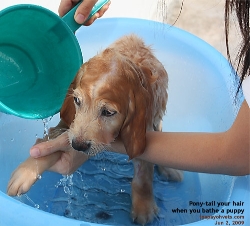 Advert for Veterinary Technicians Advert for Veterinary Technicians
or Nurses For Toa Payoh Vets |
|
BE KIND TO OLDER DOGS & CATS --- GET TUMOURS
REMOVED EARLY --- WHEN THEY ARE SMALLER.
More case studies, goto:
Cats or
Dogs |
|
|
To
make an appointment: e-mail
judy@toapayohvets.com
tel: +65 9668-6469, 6254-3326 |
 toapayohvets.com toapayohvets.com
Be Kind To Pets
Veterinary Education
Project 2010-0129 |
|
|
 Toa
Payoh Vets Toa
Payoh Vets
Clinical Research
|
|
|
Copyright ©
Asiahomes Internet
All rights reserved. Revised: September 21, 2011
Toa Payoh Vets |
|
 TOA
PAYOH VETS
TOA
PAYOH VETS TOA
PAYOH VETS
TOA
PAYOH VETS